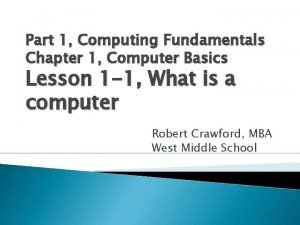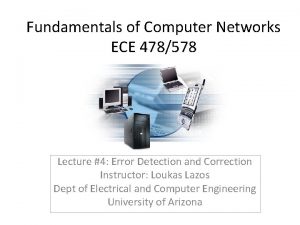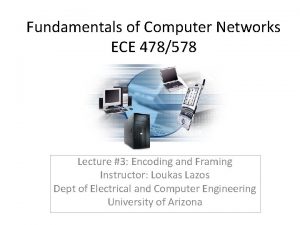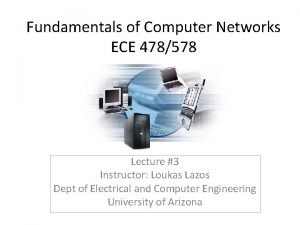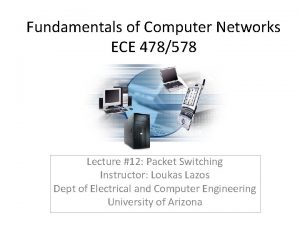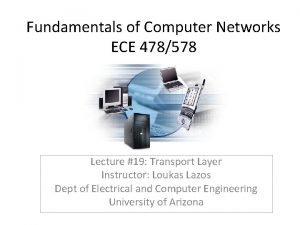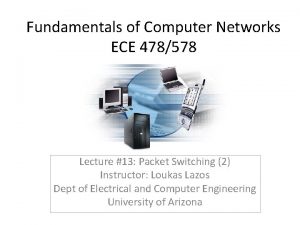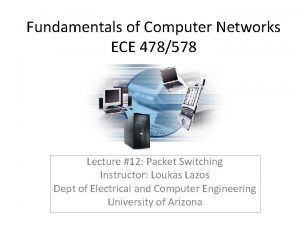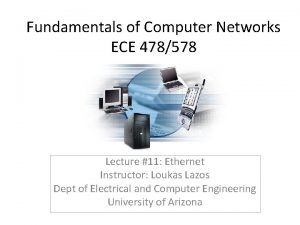Fundamentals of Computer Networks ECE 478578 Lecture 7















- Slides: 15

Fundamentals of Computer Networks ECE 478/578 Lecture #7: Reliable Transmission Instructor: Loukas Lazos Dept of Electrical and Computer Engineering University of Arizona

Reliable Transmission strategies under a lossless channel Simplex connection Simplex Stop-and-wait Transmission Strategies under a lossy channel Process of retransmitting frames that cannot be corrected by CRC codes Stop-and-wait Go-back-N Selective repeat 2

Simplex Protocol – Lossless Channel Data flows one direction only Communication channel never loses frames Sender Receiver request reply negotiate ack Receiver is always ready to receive packets Problem: receiver can be flooded if it does not process packets fast enough . . . Solution: Introduce delay at sender 3

Simplex Protocol – Lossy Channel Stop-and-wait 4

Failure of the Stop-and-Wait ACK is lost or arrives after timeout 5

Solution based on Sequence No Use a one-bit sequence number on the header Sender Receiver Fram e 0 ACK Fram e 0 Fram e 1 ACK Fram e 0 6

(In)Efficiency of Stop-and-Wait Example: Consider 1. 5 Mbps link, 45 ms RTT Delay x Bandwidth =67. 5 kb = 8 KB If frames are 1 KB long then max rate 1024 x 8 /0. 045 = 182 Kbps Only 1/8 th of link’s capacity Goal: keep the pipe full, i. e. have maximum # of bits unacknowledged at any given time Our example, we could have 8 frames unacknowledged 7

Go-back-N Protocol Main idea: Leave up to N frames unacknowledged at any given time 8

Go-Back-N Each frame is assigned a Seq. Num Variables at the sender SWS: Send Window Size LAR: Last Acknowledgment Received LFS: Last Frame Sent Rule: LFS – LAR SWS (at most SWS frames un. ACKed) Variables at the receiver RWS: Receive Window Size LAF: Largest Acceptable Frame (in seq #) LFR: Last Frame Received Rule: LAF – LFR RWS 9

Sliding Window Depicted At the sender At the receiver 10

Updating Variables SWS Sender Variables LSFi LARi Si RWS Receiver Variables LFRi LAFi Si = LFRi+1 (Go-back-N only accepts packets in order) Si LAFi (which is guaranteed in our case, for RWS 1) LSFi+1 =LSF + 1, LFRi+1 = LFRi + 1, LAFi+1 = LAFi + 1 Window at sender advanced only if ACK received 11

Example of Go-Back-N SWS = 4 LFS = 4 LAR = 0 Sender Timeout Receiver 2 0 1 4 3 1 2 RWS = 1 LFR = 0 LAF = 1 discarded Max Sequence Number SWS + 1 Link does not re-arrange packets 12

Piggypacking Duplex communication, attach ACK on the reply frame Asymmetry in frame size can cause timeouts Go-Back-N can be turned into Stop-and-Wait Sender Receiver 13

Selective Repeat Window size can be very large for nets with large delay x bandwidth Inefficient to retransmit all N frames if one is lost Selective repeat allows the re-transmission of only the lost packets Accepts out-of-order packets Simply increase the RWS up to SWS (does not make sense to allow for RWS > SWS) 14

Example of Selective Repeat SWS = 4 LFS = 4 LAR = 0 LFS = 4 LAR = 4 Sender Timeout Receiver 2 0 1 3 4 1 RWS = 4 LFR = 0 LAF = 4 Buffered 5 6 7 Max Sequence Number 2 SWS 15
 Origins of vc and datagram networks
Origins of vc and datagram networks Basestore iptv
Basestore iptv 01:640:244 lecture notes - lecture 15: plat, idah, farad
01:640:244 lecture notes - lecture 15: plat, idah, farad Logic and computer design fundamentals
Logic and computer design fundamentals Logic and computer design fundamentals
Logic and computer design fundamentals Logic and computer design fundamentals
Logic and computer design fundamentals Logic and computer design fundamentals
Logic and computer design fundamentals Fundamentals of computer graphics
Fundamentals of computer graphics Fundamentals of computer graphics
Fundamentals of computer graphics Computer fundamentals chapter 1
Computer fundamentals chapter 1 Fundamentals of computer design
Fundamentals of computer design Computer fundamentals anita goel
Computer fundamentals anita goel Fundamentals of computer design
Fundamentals of computer design Computer security fundamentals 4th edition
Computer security fundamentals 4th edition Fundamentals of computer programming syllabus
Fundamentals of computer programming syllabus Logic & computer design fundamentals
Logic & computer design fundamentals









